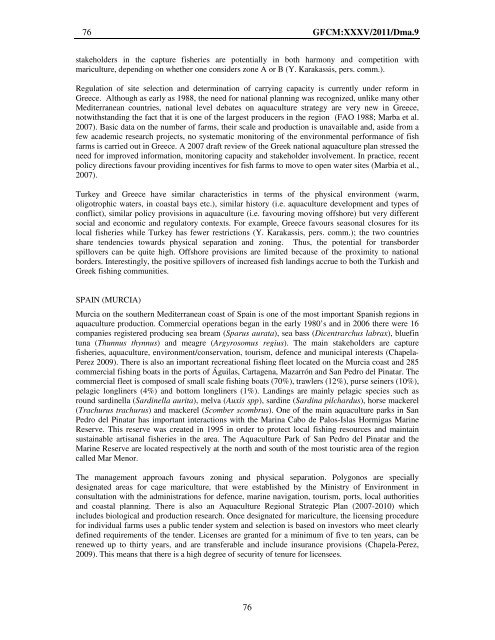Site selection and carrying capacity in Mediterranean ... - FAO Sipam
Site selection and carrying capacity in Mediterranean ... - FAO Sipam
Site selection and carrying capacity in Mediterranean ... - FAO Sipam
Create successful ePaper yourself
Turn your PDF publications into a flip-book with our unique Google optimized e-Paper software.
76 GFCM:XXXV/2011/Dma.9<br />
stakeholders <strong>in</strong> the capture fisheries are potentially <strong>in</strong> both harmony <strong>and</strong> competition with<br />
mariculture, depend<strong>in</strong>g on whether one considers zone A or B (Y. Karakassis, pers. comm.).<br />
Regulation of site <strong>selection</strong> <strong>and</strong> determ<strong>in</strong>ation of <strong>carry<strong>in</strong>g</strong> <strong>capacity</strong> is currently under reform <strong>in</strong><br />
Greece. Although as early as 1988, the need for national plann<strong>in</strong>g was recognized, unlike many other<br />
<strong>Mediterranean</strong> countries, national level debates on aquaculture strategy are very new <strong>in</strong> Greece,<br />
notwithst<strong>and</strong><strong>in</strong>g the fact that it is one of the largest producers <strong>in</strong> the region (<strong>FAO</strong> 1988; Marba et al.<br />
2007). Basic data on the number of farms, their scale <strong>and</strong> production is unavailable <strong>and</strong>, aside from a<br />
few academic research projects, no systematic monitor<strong>in</strong>g of the environmental performance of fish<br />
farms is carried out <strong>in</strong> Greece. A 2007 draft review of the Greek national aquaculture plan stressed the<br />
need for improved <strong>in</strong>formation, monitor<strong>in</strong>g <strong>capacity</strong> <strong>and</strong> stakeholder <strong>in</strong>volvement. In practice, recent<br />
policy directions favour provid<strong>in</strong>g <strong>in</strong>centives for fish farms to move to open water sites (Marbia et al.,<br />
2007).<br />
Turkey <strong>and</strong> Greece have similar characteristics <strong>in</strong> terms of the physical environment (warm,<br />
oligotrophic waters, <strong>in</strong> coastal bays etc.), similar history (i.e. aquaculture development <strong>and</strong> types of<br />
conflict), similar policy provisions <strong>in</strong> aquaculture (i.e. favour<strong>in</strong>g mov<strong>in</strong>g offshore) but very different<br />
social <strong>and</strong> economic <strong>and</strong> regulatory contexts. For example, Greece favours seasonal closures for its<br />
local fisheries while Turkey has fewer restrictions (Y. Karakassis, pers. comm.); the two countries<br />
share tendencies towards physical separation <strong>and</strong> zon<strong>in</strong>g. Thus, the potential for transborder<br />
spillovers can be quite high. Offshore provisions are limited because of the proximity to national<br />
borders. Interest<strong>in</strong>gly, the positive spillovers of <strong>in</strong>creased fish l<strong>and</strong><strong>in</strong>gs accrue to both the Turkish <strong>and</strong><br />
Greek fish<strong>in</strong>g communities.<br />
SPAIN (MURCIA)<br />
Murcia on the southern <strong>Mediterranean</strong> coast of Spa<strong>in</strong> is one of the most important Spanish regions <strong>in</strong><br />
aquaculture production. Commercial operations began <strong>in</strong> the early 1980’s <strong>and</strong> <strong>in</strong> 2006 there were 16<br />
companies registered produc<strong>in</strong>g sea bream (Sparus aurata), sea bass (Dicentrarchus labrax), bluef<strong>in</strong><br />
tuna (Thunnus thynnus) <strong>and</strong> meagre (Argyrosomus regius). The ma<strong>in</strong> stakeholders are capture<br />
fisheries, aquaculture, environment/conservation, tourism, defence <strong>and</strong> municipal <strong>in</strong>terests (Chapela-<br />
Perez 2009). There is also an important recreational fish<strong>in</strong>g fleet located on the Murcia coast <strong>and</strong> 285<br />
commercial fish<strong>in</strong>g boats <strong>in</strong> the ports of Águilas, Cartagena, Mazarrón <strong>and</strong> San Pedro del P<strong>in</strong>atar. The<br />
commercial fleet is composed of small scale fish<strong>in</strong>g boats (70%), trawlers (12%), purse se<strong>in</strong>ers (10%),<br />
pelagic longl<strong>in</strong>ers (4%) <strong>and</strong> bottom longl<strong>in</strong>ers (1%). L<strong>and</strong><strong>in</strong>gs are ma<strong>in</strong>ly pelagic species such as<br />
round sard<strong>in</strong>ella (Sard<strong>in</strong>ella aurita), melva (Auxis spp), sard<strong>in</strong>e (Sard<strong>in</strong>a pilchardus), horse mackerel<br />
(Trachurus trachurus) <strong>and</strong> mackerel (Scomber scombrus). One of the ma<strong>in</strong> aquaculture parks <strong>in</strong> San<br />
Pedro del P<strong>in</strong>atar has important <strong>in</strong>teractions with the Mar<strong>in</strong>a Cabo de Palos-Islas Hormigas Mar<strong>in</strong>e<br />
Reserve. This reserve was created <strong>in</strong> 1995 <strong>in</strong> order to protect local fish<strong>in</strong>g resources <strong>and</strong> ma<strong>in</strong>ta<strong>in</strong><br />
susta<strong>in</strong>able artisanal fisheries <strong>in</strong> the area. The Aquaculture Park of San Pedro del P<strong>in</strong>atar <strong>and</strong> the<br />
Mar<strong>in</strong>e Reserve are located respectively at the north <strong>and</strong> south of the most touristic area of the region<br />
called Mar Menor.<br />
The management approach favours zon<strong>in</strong>g <strong>and</strong> physical separation. Polygonos are specially<br />
designated areas for cage mariculture, that were established by the M<strong>in</strong>istry of Environment <strong>in</strong><br />
consultation with the adm<strong>in</strong>istrations for defence, mar<strong>in</strong>e navigation, tourism, ports, local authorities<br />
<strong>and</strong> coastal plann<strong>in</strong>g. There is also an Aquaculture Regional Strategic Plan (2007-2010) which<br />
<strong>in</strong>cludes biological <strong>and</strong> production research. Once designated for mariculture, the licens<strong>in</strong>g procedure<br />
for <strong>in</strong>dividual farms uses a public tender system <strong>and</strong> <strong>selection</strong> is based on <strong>in</strong>vestors who meet clearly<br />
def<strong>in</strong>ed requirements of the tender. Licenses are granted for a m<strong>in</strong>imum of five to ten years, can be<br />
renewed up to thirty years, <strong>and</strong> are transferable <strong>and</strong> <strong>in</strong>clude <strong>in</strong>surance provisions (Chapela-Perez,<br />
2009). This means that there is a high degree of security of tenure for licensees.<br />
76
















